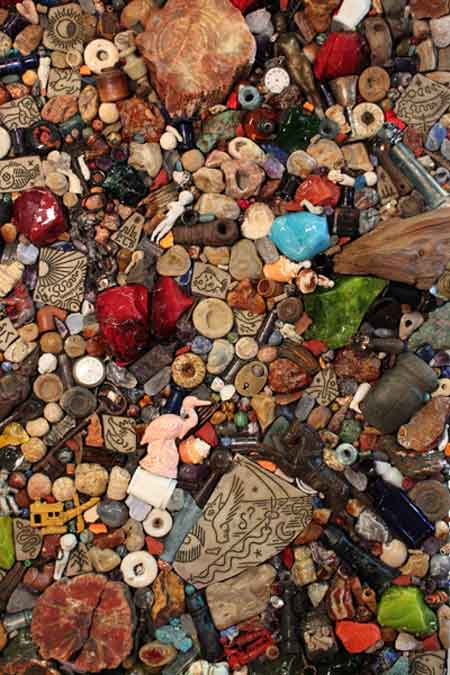Thinset mortar can be used on a plywood mosaic backer provided the plywood has been sealed with a white PVA adhesive such as Weldbond. Otherwise, the plywood can suck the moisture out of the thinset before it has a chance to harden leaving it soft and crumbly. It is important to seal the plywood at least a day or two before you mount the mosaic with thinset because the Weldbond needs to be thoroughly dry and cured. For sealing purposes, Weldbond can be painted on with a brush or spread with a trowel. Many mosaic artists dilute the glue slightly or even up to 1:1 with water to make it easier to spread. Note that you shouldn’t seal your plywood with paint or sealers chosen at random because thinset will not bond to some of the oil-based and silicone-based products.
Some artists seal their plywood backers with Weldbond before mosaicing even if they are going to use that same Weldbond to mount the tiles. Why? They want to make sure that the entire surface of the plywood has been sealed so that it doesn’t suck the moisture out of the GROUT when it cures. I never worry about sealing the face of my plywood because I am sure that I will get enough Weldbond spread around when I mount my tile, and so pre-sealing seems like an unnecessary extra step to me.
Sealing VS Sealing
A note of clarification: In this article, I am talking about pre-sealing the face of the plywood with Weldbond or some other PVA adhesive. This is a different step from sealing the finished mosaic a few days after grouting with a tile and grout sealer or “sealing” the edges and back of the plywood with paint or varnish to prevent warping by moisture.
When You Should and Should NOT Use Plywood
Plywood can warp and delaminate over time merely from the humidity in the air, and so you should never use plywood as a backer for outdoor mosaic or a mosaic in a damp location. However, plywood makes a great backer for dry indoor mosaics and not just for its light weight, which in itself is a significant advantage over concrete backer board. Unlike concrete backer board, the edges of plywood can be stained or painted, and they do not shed crumbs of concrete and sand. In my opinion, concrete backer board should only be used inside walls and floors and other places where its crumbly edges are covered up; it is not a backer for moveable mosaic plaques.
Use Cabinet-Grade Plywood
Note that you should spend the extra money and buy cabinet-grade plywood (in 1/2 inch thickness) instead of the ordinary plywood used for sheathing in construction. The cabinet-grade stuff comes with a sanded finish and has no knots or internal voids. It is also more resistant to warping, and the edges of cut pieces are cleaner than those cut from regular plywood mainly due to the lack of voids in the internal plies. With all of these advantages, the cabinet-grade plywood is only about 15% to 25% more than regular plywood, and in real terms it is actually the same price: some of the regular plywood may need to be scrapped due to internal voids, and it will require more work to make the edges presentable. The edges of a cut piece of cabinet grade plywood can be left plain or painted. The edges of a cut piece of regular plywood will have voids and require putty, sanding and paint if not a frame to look presentable.
Why Use Thinset on Plywood?
If plywood can only be used for dry indoor mosaics, then why would someone need to use thinset mortar on a piece of plywood anyway? The simple answer is there isn’t any reason to do so (IF you are using regular flat tile). With flat glass tile, you simply glue the tile on with Weldbond or some other PVA adhesive, let it dry for a day or so and then grout it by rubbing wet grout into the gaps and wiping away the excess.
However, some people (including myself) like to use rounded and irregularly-shaped found objects in our mosaics, and these are not easily grouted. Instead of the glue-then-grout method, we like to press our objects into a bed of mortar so that the excess mortar presses up slightly around the object and skip grouting entirely. It is also necessary to avoid grouting if your found objects are naturally porous (seashells, bones, unpolished stones) because grout will stain these materials.


Leave a Reply